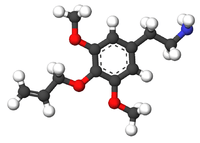Allylescaline
 | |
 | |
| Names | |
|---|---|
| IUPAC names
4-Allyloxy-3,5-dimethoxyphenethylamine 4-Allyloxy-3,5-dimethoxy-1-ethylamine | |
| Identifiers | |
| 39201-75-7 | |
| 3D model (Jmol) | Interactive image |
| ChEMBL | ChEMBL126803 |
| ChemSpider | 21106254 |
| |
| |
| Properties | |
| C13H19NO3 | |
| Molar mass | 237.29 g/mol |
| Except where otherwise noted, data are given for materials in their standard state (at 25 °C [77 °F], 100 kPa). | |
| | |
| Infobox references | |
Allylescaline, or 4-allyloxy-3,5-dimethoxyphenethylamine, is a lesser-known psychedelic drug. It is closely related in structure to mescaline. AL was first synthesized by Otakar Leminger in 1972.[1] The compound was later synthesized by Alexander Shulgin and further described in his book PiHKAL (Phenethylamines i Have Known And Loved). The dosage range is listed as 20–35 mg, and the duration 8-12 hours.[2] Allylescaline produces an entactogenic warmth, an entheogenic effect, and a feeling of flowing energy. Very little data exists about the pharmacological properties, metabolism, and toxicity of allylescaline.
Legal status
Allylescaline is illegal in Sweden as of 26. January 2016.[3]
See also
- Proscaline
- Phenethylamine
- Psychedelics, dissociatives and deliriants
- Substituted phenethylamine
- Elemicin
References
- ↑ Leminger, Otakar (1972). "The Chemistry of Alkoxylated Phenethylamines - Part 2". Chemický průmysl. 22: 553.
- ↑ Shulgin, Alexander; Ann Shulgin (September 1991). PiHKAL: A Chemical Love Story. Berkeley, California: Transform Press. ISBN 0-9630096-0-5. OCLC 25627628.
- ↑ "31 nya ämnen kan klassas som narkotika eller hälsofarlig vara" (in Swedish). Folkhälsomyndigheten. November 2015.
External links
This article is issued from Wikipedia - version of the 1/7/2016. The text is available under the Creative Commons Attribution/Share Alike but additional terms may apply for the media files.